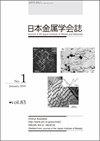钢中板条马氏体的形成机理
IF 0.4
4区 材料科学
Q4 METALLURGY & METALLURGICAL ENGINEERING
引用次数: 7
摘要
低碳钢中形成的板条马氏体对含0.1%质量%C的耐热钢的力学性能起着至关重要的作用。板条马氏体呈现由包、块和板条组成的分层微观结构。马氏体相变是伴随有序剪切变形而不发生原子扩散的相变。由于变形引起的应变能松弛,形成了分层微观结构;然而,据我们所知,这种微观结构的形成机制迄今尚未被理解。本文综述了迄今为止报道的实验结果和现象学形成机制,并介绍了一种新的机制(包括两种滑移变形(TTSD)模型),该机制是在哈查图尔良提出的滑移变形模型的基础上,独立考虑两种滑移变形而构建的。此外,TTSD模型允许通过相场法模拟马氏体相的形成。此外,TTSD模型允许预测板条马氏体特征,包括板条中存在子块和高密度位错。特别是,TTSD模型第一次清楚地解释了块结构中板条的存在。(doi: 10.2320 / matertrans.M2016430)本文章由计算机程序翻译,如有差异,请以英文原文为准。
Formation Mechanism of Lath Martensite in Steels
Lath martensite formed in low carbon steels plays a crucial role in the mechanical properties of heat-resistant steels containing approximately 0.1 mass%C. Lath martensite exhibits a hierarchical microstructure comprising packets, blocks and laths. Martensitic transformation is the phase transformation accompanying ordered shear deformation without atom diffusion. The hierarchical microstructure is formed as a result of the relaxation of the strain energy caused by the deformation; however, to the best of our knowledge, the formation mechanism of this microstructure has not been understood thus far. In this paper, the experimental results and phenomenological formation mechanism reported thus far are reviewed, and a new mechanism (including two types of slip deformation (TTSD) model) is introduced, which is constructed by independently considering two kinds of slip deformations using the slip deformation model proposed by Khachaturyan. In addition, the TTSD model allows for the simulation of the martensite phase formation by the phaseeld method. Furthermore, the TTSD model permits the prediction of lath martensite features including the existence of sub-blocks and high density of dislocations in lath. In particular, the presence of laths in a block structure is clearly explained by the TTSD model for the rst time. [doi:10.2320/matertrans.M2016430]
求助全文
通过发布文献求助,成功后即可免费获取论文全文。
去求助
来源期刊

Journal of The Japan Institute of Metals
工程技术-冶金工程
CiteScore
0.70
自引率
0.00%
发文量
27
审稿时长
6-12 weeks
期刊介绍:
Information not localized
 求助内容:
求助内容: 应助结果提醒方式:
应助结果提醒方式:


